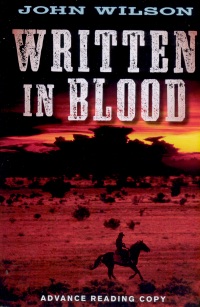| ________________
CM . . .
. Volume XVII Number 13. . . .November 26, 2010 
 |
Written in Blood.
John Wilson.
Victoria, BC: Orca, 2010.
157 pp., pbk., $12.95.
ISBN 978-1-55469-270-5.
Grades 5-9 / Ages 10-14.
Review by Meredith Snyder,
* /4
Reviewed from Advance Reading Copy. |
| |
|

excerpt:
Civilization's creeping in, but it's a slow violent process.
John Wilson's latest historical novel, Written in Blood, has all the markers of a classic Western. James Doolen, a determined, skilled boy of 16, sets out from the home he shares with his mother in Yale, British Columbia, to find out what happened to his father who left the family several years previously and never returned. James has little to go on but a letter he found in the lining of his father's gun box suggesting that he had left for Casas Grandes in Mexico, and his own strong skills at shooting, riding, and hunting.
The Western is a vivid, once-popular genre that relies on stereotypic, stock characters to tell thrilling, violent stories. Larger-than-life white men with ruddy, sunburned faces fight against the massive, cartoonish threat of an undifferentiated, uncivilized indigenous mass. The genre has declined in popularity in recent years, perhaps in part because of a growing awareness of the harmfulness of such cultural stereotypes. It is no longer acceptable for children's literature to perpetuate racist ideologies. While white schoolboys may be seeking brave role models in fiction, this should never be at the expense of First Nations children. Any attempt to revive and revise this problematic genre is a risky undertaking.
In his latest novel, Wilson attempts a radical rewrite of the Western. Why not keep all the heart-stopping adventure of the classic dime novel but purging the story of its racist aspects? Wilson's writing is vivid, and there is little doubt that Written in Blood was written with the most respectful of intentions. He even directly addresses the problematic aspects of the dime novels from which he takes his inspiration. The story is situated within recorded historical moment and explains some practices, such as scalping, in a balanced, factual way. As he encounters "Wellington" and Nah-kee-tats-an, James Doolen, the story's point-of'-view character, moves from an overly simplistic understanding of the Apache to a more complex one. Readers might share James's growing sympathy.
But the book was still clearly written with a white audience in mind. Discussion of whether or not indigenous people are "savages" and whether their culture is uncivilized presuppose that the reader already holds this harmful opinion and needs to be convinced otherwise. In order to deconstruct stereotypes, the book first establishes them. Wilson uses loaded words such as "wild" to describe "Indians," but refers to other cultures in neutral terms. "Wellington" is a silly man and a traitor, laughed at by his own son. He values the Europeans' writing system over the rich oral tradition of his people, and he went to work for the white men because he considered the Apache's situation hopeless. Although he might make many readers laugh, this foolish character could be embarrassing and hurtful to a Native reader.
Written in Blood perpetuates the same racist ideology that it attempts to dismantle. The narrative of colonization and the idea of bringing civilization to an untamed land, which informs much of the novel, have been used to justify some of the worst atrocities of North American history. Though James ultimately concludes that his Apache friends are more "civilized" than his father's violent family, they are presented as such in European terms rather than within the context of their own complex culture. The two-dimensional indigenous characters, which range from romanticized to ridiculous, are in no way a fair portrayal of Apache cultures. While a culturally sensitive rewrite of the Western genre could be a great read and surely appeal to reluctant readers, this novel does not live up to its potential.
Not recommended.
Meredith Snyder is a graduate student at the Ontario Institute for Studies in Education in Toronto, ON.
 To comment
on this title or this review, send mail to cm@umanitoba.ca.
To comment
on this title or this review, send mail to cm@umanitoba.ca.
Copyright © the Manitoba Library Association. Reproduction for personal
use is permitted only if this copyright notice is maintained. Any
other reproduction is prohibited without permission.
NEXT REVIEW |
TABLE OF CONTENTS FOR THIS ISSUE
- November 26, 2010.
AUTHORS |
TITLES |
MEDIA REVIEWS |
PROFILES |
BACK ISSUES |
SEARCH |
CMARCHIVE |
HOME |
|
